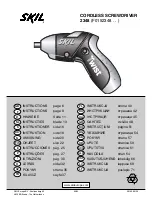
14
| English
Drill
GBM 13-2 RE
Clockwise/anticlock-
wise rotation
●
●
●
●
●
●
●
Overload clutch
●
●
●
●
●
●
●
Keyless chuck with se-
curing ring
●
–
–
–
–
–
●
Keyless chuck
–
●
–
●
●
●
–
Keyed chuck
–
–
●
–
–
–
–
Max. drilling diameter (1st/2nd gear)
– Steel
mm
13/8
13/8
13/8
13/8
13/8
13/8
13/8
– Wood
mm
32/20
32/20
32/20
32/20
32/20
32/20
32/20
– Aluminium
mm
20/12
20/12
20/12
20/12
20/12
20/12
20/12
Chuck capacity
mm
1–13
1–13
1–13
1–13
1–13
1–13
1–13
Weight according to
EPTA-Procedure
01:2014
kg
2.4
2.4
2.4
2.4
2.4
2.4
2.4
Protection class
/ II
/ II
/ II
/ II
/ II
/ II
/ II
The specifications apply to a rated voltage [U] of 230 V. These specifications may vary at different voltages and in country-specific models.
Noise/vibration information
Noise emission values determined according to
EN 62841-2-1
.
Typically, the A-weighted noise level of the power tool is:
Sound pressure level
82
dB(A); sound power level
93
dB(A). Uncertainty K =
5
dB.
Wear hearing protection
Vibration total values a
h
(triax vector sum) and uncertainty K
determined according to
EN 62841-2-1
.
Drilling into metal: a
h
=
8.0
m/s
2
, K =
1.5
m/s
2
The vibration level and noise emission value given in these
instructions have been measured in accordance with a
standardised measuring procedure and may be used to com-
pare power tools. They may also be used for a preliminary
estimation of vibration and noise emissions.
The stated vibration level and noise emission value repres-
ent the main applications of the power tool. However, if the
power tool is used for other applications, with different ap-
plication tools or is poorly maintained, the vibration level
and noise emission value may differ. This may significantly
increase the vibration and noise emissions over the total
working period.
To estimate vibration and noise emissions accurately, the
times when the tool is switched off or when it is running but
not actually being used should also be taken into account.
This may significantly reduce vibration and noise emissions
over the total working period.
Implement additional safety measures to protect the oper-
ator from the effects of vibration, such as servicing the
power tool and application tools, keeping their hands warm,
and organising workflows correctly.
Assembly
u
Pull the plug out of the socket before carrying out any
work on the power tool.
Auxiliary handle (see figure A)
u
Do not operate your power tool without the auxiliary
handle
(9)
.
You can adjust the auxiliary handle
(9)
to any of 12 positions
in order to achieve a safe work posture that minimises fa-
tigue.
Turn the lower gripping end of the auxiliary handle
(9)
in ro-
tational direction
➊
and push the auxiliary handle
(9)
for-
ward until you can swivel it into the required position. Then
pull the auxiliary handle
(9)
back again and turn the lower
gripping end in rotational direction
➋
to tighten it.
Setting the drilling depth (see figure A)
You can use the depth stop to set the required drilling depth
X
.
Turn the lower gripping end of the auxiliary handle
(9)
anti-
clockwise and set the depth stop
(10)
.
Pull the depth stop far enough out that the distance between
the drill bit tip and the edge of the depth stop corresponds
to the required drilling depth
X
.
Then, turn the lower gripping end of the auxiliary handle
(9)
clockwise to retighten it.
The fluting on the depth stop
(10)
must face upwards.
Changing the tool
u
Pull the plug out of the socket before carrying out any
work on the power tool.
u
Wear protective gloves when changing tools.
The drill
chuck may heat up significantly when it is used for long
periods.
1 609 92A 5H2 | (20.11.2019)
Bosch Power Tools















































